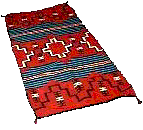
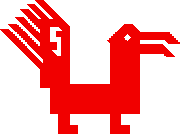
Navajo Rug Appraisal Co.®
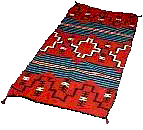
Carpet Beetles
Identification
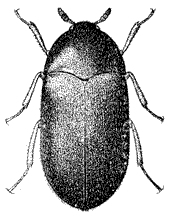 Adult
Adult Larva
Larva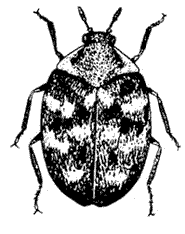 Adult
Adult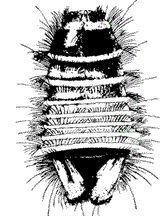 Larva
Larva
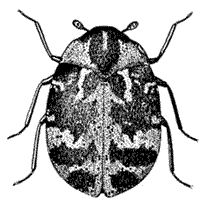 Adult
Adult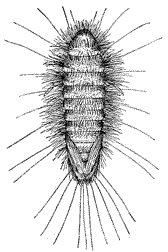 Larva
Larva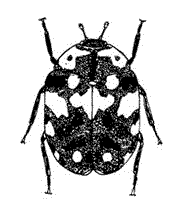 Adult
Adult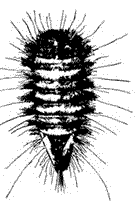 Larva
LarvaLife Cycle and Habits
All carpet beetles pass through the egg, larva, pupa and adult stages. Adults fly readily and during warm, sunny days feed outdoors on flower pollen of spirea, dogwood, crepe myrtle and buckwheat that have white or cream-colored flowers. Others feed on daisies, wild asters, etc. Adults are attracted by light, fly into homes and may be found on windows and screens. Depending on the species, each female can lay up to 100 white eggs or more that hatch in 8 to 15 days in warm weather. Eggs laid indoors occur in lint accumulations near the food source, in air ducts, under heavy furniture, underneath baseboards, etc. After hatching, larvae begin their destructive feeding, avoiding light, and molting several times as they develop. Sixty days to a year or more may be spent in the larval stage feeding, depending on food and temperature. Some life cycles are two to three years, depending on the species of carpet beetle. When rooms are warm indoors, the life cycle is shorter than in an unheated portion of the house during the winter. In the spring, the pupa stage is followed by new adults. Usually there are three to four generations per year except for the black or varied carpet beetle that may have one generation per year.
Control Measures
Inspection: Locate the source of infestation before treatment. Carpet beetle larvae prefer to feed in dark, undisturbed, protected places. Use a flashlight and nail file to check in such places as under baseboards, in and under upholstered furniture, piano felts, air ducts, stuffed animal trophies, stored cereals, bird nests under eaves, rodent nests, wasp nests in attics, dead birds or rodents in wall voids, woolens, clothes closets, furs, etc. Often the cast skins are more abundant than the larvae. Adult beetles flying around windows may help in locating the infestation.
Prevention: Good housekeeping is critical. Use a strong suction vacuum cleaner with proper attachments to remove lint, hair and dust from floors, shelves and drawers. Periodically brush, air outside, or dry-clean furs, woolens, blankets, etc. Clean rugs, carpets, draperies, furniture, baseboards, air vents, moldings and other hard-to-reach places regularly. Destroy untreated worthless animal skins or hides, valueless insect collections, old woolen rags and old clothing. Cedar-lined closets and chests help but are not 100 percent effective. Be sure that all cloth goods are dry-cleaned, washed, pressed with a hot iron, sunned or brushed prior to storage. Fur storage in cold vaults is effective. Remove and destroy abandoned bird and insect nests in attics, under eaves, etc.
Control of rug-damaging insects: If rugs are to be stored for any extended length of time, they should first be cleaned and then mothproofed. Para-dichlorobenzine or naphthalene moth crystals or moth balls are very dangerous to your health and should be avoided (assuming that PDB actually helps prevent moth infestation). These chemicals have been linked to increased fluid pressure within the eyes, anemia and liver damage. Clearly, the odor from PDB never seems to diminish completely. Each rug should be then wrapped in paper rather than plastic as the latter does little to keep out rodents and could possibly cause condensation to form within the package (very slight probability but possible nonetheless). The rugs should the be placed in an area safe from moisture or other harm, away from the walls and off the floor. Cedar lined closets and chests should not be relied upon for complete protection from destructive insects. Also there seems to be only anecdotal evidence supporting such preventatives as newsprint, bay leaves or pepper. The placement of feathers as a bait in order to distract the moths is also unwise as it probably only serves to encourage the problem.
Concern about insect damage should not be limited to stored rugs. Rugs kept in rooms with little traffic or daylight or with portions of carpets that extend under furniture are also subject to moth and beetle infestation. Rugs and weaving that are hanging on walls are particularly susceptible to insect infestation. Even actively used rooms can harbor hordes of destructive insects if they or their food source remain undisturbed. Under ideal conditions, rugs can suffer extensive damage in a surprisingly short time.
If damage or evidence of infestation is discovered on your rugs, send your rugs to us to be cleaned and treated with our moth-proofing/carpet beetle solution. Freezing the rugs in a chest freezer is no guarantee of extermination because the temperatures may not be cold enough for a complete kill. Insect foggers are effective in killing infestation of flying beetles and larvae if used properly along with thorough vacuuming and additional "moth proofing." Caution should be used concerning exposure of vapor to valuable paintings etc. Be advised that the rugs need to be spread flat and should be flipped and fogged again in order to be more certain of effective extermination. Check to see if the infestation extends to other areas of the home, such as wool garments or furniture. It is best to be thorough.
We sell a very effective product that protects against carpet beetles and moths that is safe to use on Navajo rugs.
Please see our page: here.
 Navajo Rug Appraisal Co.®
Navajo Rug Appraisal Co.®